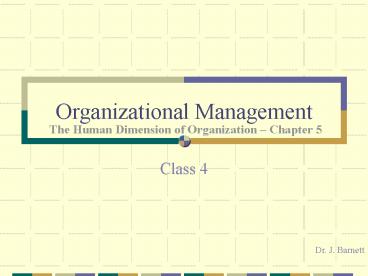Organizational Management PowerPoint PPT Presentation
1 / 9
Title: Organizational Management
1
Organizational Management
The Human Dimension of Organization Chapter 5
- Class 4
Dr. J. Barnett
2
Refer to pp. 131 text
- Role a psychological concept dealing with
behaviour enactment arising from interaction with
other human beings within a social structure (an
organization)
Role description ones perception of behaviour
in a role Role prescription abstract idea of
general norm for the role
in the culture Role expectation the
expectation that one person has of the
role behaviour of another Role
perception the perception that one has of the
role expectation
that another holds for him/her Manifest and
latent roles other obvious roles / and not
obvious roles
3
Role Seta group of roles who function together
in a organization hierarchical subordinates and
superordinates
- group task roles
- these roles helps the group to select
..and work on issues - group building and maintenance roles
- these roles facilitate the development
..and maintained over time - individual roles
- these roles enable individual to meet
.own needs over time
4
Getzels-Guba Model (when Role meets Systems
Theory)
5
(No Transcript)
6
Class Two
- Theory Z (Ouchi, 1981) any workers life is a
whole, not Jekyll-Hyde same human at work as
out humanizing work conditions increases
productivity as well as employee self-esteem
focus needs to be on human relations not
technology
Class Three
- Human Resources Development Views
- emphasizes using the conscious thinking of
individual person about what they are doing a
means of involving their commitment, their
abilities, and their energies in achieving the
goals of the organization.
New concept bottom-up / build human capital
7
Five basic Assumptions of Effective Schools
(pp. 172-173 in text)
- The central purpose of a school is to teach.
- The school is responsible for providing the
overall environment. - Schools must be treated holistically in terms of
instruction (unity) - The most crucial characteristics of a school are
the attitudes and behaviours of the teachers and
staff - The school accepts responsibility for the success
or failure of the academic performance of
students all students are capable of learning.
8
13 Organizational and Operational Characteristics
of Effective Schools
pp. 173-174
- School-site management and democratic decision
making - Support from the district with a decrease in
central management - Strong leadership (in different forms)
- Staff stability to develop strong school culture
- A Holistic planned curriculum
- School-wide professional development based on
needs of school and individual teachers - Parental involvement (homework discipline)
- Recognition of academic success
- Time focused on learning (reduced interruptions)
- Collaborative planning
- Sense of community
- Shared goals and high achievable expectations
- Order and discipline rules / expectations for
this community of people
9
(No Transcript)

